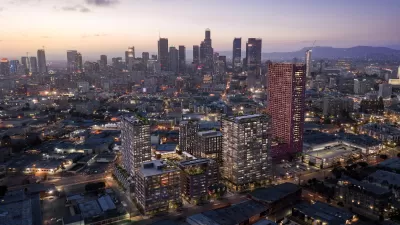Scott Beyer details the old real estate wisdom of "retail follows rooftops," especially as evidenced by cities like Cleveland in recent years.

Scott Beyer begins an article for Governing by noting that Downtown Cleveland has all the trappings of a full-blown downtown renaissance: "Downtown Cleveland right now has its highest-ever population, with more than 13,000 residents and lots of new housing developments on the way. There are more than 4,000 hotel rooms, with another thousand expected by 2016."
Yet there's something missing:
"If you are looking for a large grocery store, however, you’re still out of luck. The first one, Heinen’s Fine Foods, is set to open soon, but residents so far have had to make do with quick marts and gourmet prepared-food delis. Even following the opening of Heinen’s, downtown Cleveland still will not have many of the amenities found in denser areas: Neither Target nor Walmart has launched one of its urban-style branches here. There’s no large office supply or electronic retailer. And the many empty storefronts remind passersby of the basic amenities they are still missing, such as a hardware shop."
Beyer notes that the example of Cleveland is one of two ways that the "retail follows rooftops" trend manifests:
"In trending Brooklyn neighborhoods like Crown Heights, for example, one still finds greasy takeouts and bodegas with bulletproof glass, rather than healthy sit-down restaurants or other amenities that newly arrived residents might want. Meanwhile, cities without a previous critical mass, like Cleveland, can have difficulty attracting retail altogether, despite their large residential presence."
Beyer goes on to examine the tools that cities use to speed up the process of retail catching up with the residential population, such as tax increment financing and business improvement districts.
FULL STORY: The Neighborhood Has Gentrified, But Where’s the Grocery Store?

Planetizen Federal Action Tracker
A weekly monitor of how Trump’s orders and actions are impacting planners and planning in America.

Chicago’s Ghost Rails
Just beneath the surface of the modern city lie the remnants of its expansive early 20th-century streetcar system.

San Antonio and Austin are Fusing Into one Massive Megaregion
The region spanning the two central Texas cities is growing fast, posing challenges for local infrastructure and water supplies.

Since Zion's Shuttles Went Electric “The Smog is Gone”
Visitors to Zion National Park can enjoy the canyon via the nation’s first fully electric park shuttle system.

Trump Distributing DOT Safety Funds at 1/10 Rate of Biden
Funds for Safe Streets and other transportation safety and equity programs are being held up by administrative reviews and conflicts with the Trump administration’s priorities.

German Cities Subsidize Taxis for Women Amid Wave of Violence
Free or low-cost taxi rides can help women navigate cities more safely, but critics say the programs don't address the root causes of violence against women.
Urban Design for Planners 1: Software Tools
This six-course series explores essential urban design concepts using open source software and equips planners with the tools they need to participate fully in the urban design process.
Planning for Universal Design
Learn the tools for implementing Universal Design in planning regulations.
planning NEXT
Appalachian Highlands Housing Partners
Mpact (founded as Rail~Volution)
City of Camden Redevelopment Agency
City of Astoria
City of Portland
City of Laramie





























